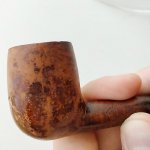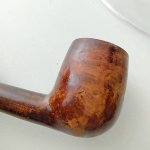? Pipe is losing dye
- Thread starter mariorossi
- Start date
You are using an out of date browser. It may not display this or other websites correctly.
You should upgrade or use an alternative browser.
You should upgrade or use an alternative browser.
SmokingPipes.com Updates
Watch for Updates Twice a Week
I don't know what it is but I hope you get some answers from some who do; I'd like to know too. My thought would be not the dye, but some type of gloss or varnish that was put on over the dye. I've seen some that were "shiny" in ways that made me not appreciate them. I prefer to see more of the wood / grain, or just have a stain.
Thats not dye. Dye penetrates the wood. That is most likely a varnish that is flaking off.
Unless you want a shiny pipe, take some 600 grit sandpaper to the thing and give it a light coat of wax. I personally hate shiny pipes.
I also dont like shiny pipes. I will do as you suggested. Thanks for the replyUnless you want a shiny pipe, take some 600 grit sandpaper to the thing and give it a light coat of wax. I personally hate shiny pipes.
Wait! Don't use sandpaper. Less abrasive is the use of something like a 3M Abrasive Pad and rubbing alcohol. That way, you will not erase all the stamping/markings. If you want to re-dye it, you can purchase leather dye on Amazon quite easily.
too late...I tried alcohol before but it did nothing to the varnish. Btw i don't care for the markings since are very cheap old pipes. Thank youWait! Don't use sandpaper. Less abrasive is the use of something like a 3M Abrasive Pad and rubbing alcohol. That way, you will not erase all the stamping/markings. If you want to re-dye it, you can purchase leather dye on Amazon quite easily.
It’s shellac and you’ve softened and removed it with water
Personally I’ll let the bowl sit into 90% alcohol and remove the remaining stain to a natural finish, after it’s up to you if you want to apply leather dye of your choice or keep it natural .
This seems to be a recurring topic of discussion lately...
The shiny areas are nitrocellulose lacquer. Alcohol doesn't dissolve nitrocellulose lacquer. Lacquer thinner or acetone softens and removes lacquer. Dampen a cloth with lacquer thinner and wipe away the old lacquer. Some of the stain will be removed with it. Stain is applied to raw wood, and a sealant, such as lacquer or shellac is applied over that.
I've read that some artisan makers use shellac (a thin cut) before final sanding as a sanding sealer. But shellac as a finish, generally isn't used, and hasn't been used, even on furniture, for over a century.
Some lower cost pipes are sealed with lacquer in order to present a shiny finish that is more durable than a regular wax finish which has to be maintained in order to look shiny.
Sanding will remove old lacquer too. However, most people are too aggressive when it comes to sanding wood, and it changes the geometry of the finished piece, usually removing any value, what little there is in the first place. There is no reset button if you sand and remove too much material.
Staining is an option once you have removed the old finish. But it does require some practice if you've never done it before in order to get good looking results.
The shiny areas are nitrocellulose lacquer. Alcohol doesn't dissolve nitrocellulose lacquer. Lacquer thinner or acetone softens and removes lacquer. Dampen a cloth with lacquer thinner and wipe away the old lacquer. Some of the stain will be removed with it. Stain is applied to raw wood, and a sealant, such as lacquer or shellac is applied over that.
I've read that some artisan makers use shellac (a thin cut) before final sanding as a sanding sealer. But shellac as a finish, generally isn't used, and hasn't been used, even on furniture, for over a century.
Some lower cost pipes are sealed with lacquer in order to present a shiny finish that is more durable than a regular wax finish which has to be maintained in order to look shiny.
Sanding will remove old lacquer too. However, most people are too aggressive when it comes to sanding wood, and it changes the geometry of the finished piece, usually removing any value, what little there is in the first place. There is no reset button if you sand and remove too much material.
Staining is an option once you have removed the old finish. But it does require some practice if you've never done it before in order to get good looking results.
Rubbing alcohol will work. "elbow grease" may be required, but it the briar will appreciate the approach.
Acetone is option "B"Rubbing alcohol will work. "elbow grease" may be required, but it the briar will appreciate the approach.
I used acetone on a rag and just wiped the outside of the pipe. It took the old finish off quick, easy, and completely. Acetone evaporates very quickly and will not harm the wood. Take the stem off though. I then sent the pipe off to be refinished. That cost me less than $30.00.
Once you get the finish off, consider leaving it unfinished, since it will color and even develop a shine or even a polish without further treatment. Just buff it by hand each time you smoke it and the "finish" will come up even.









